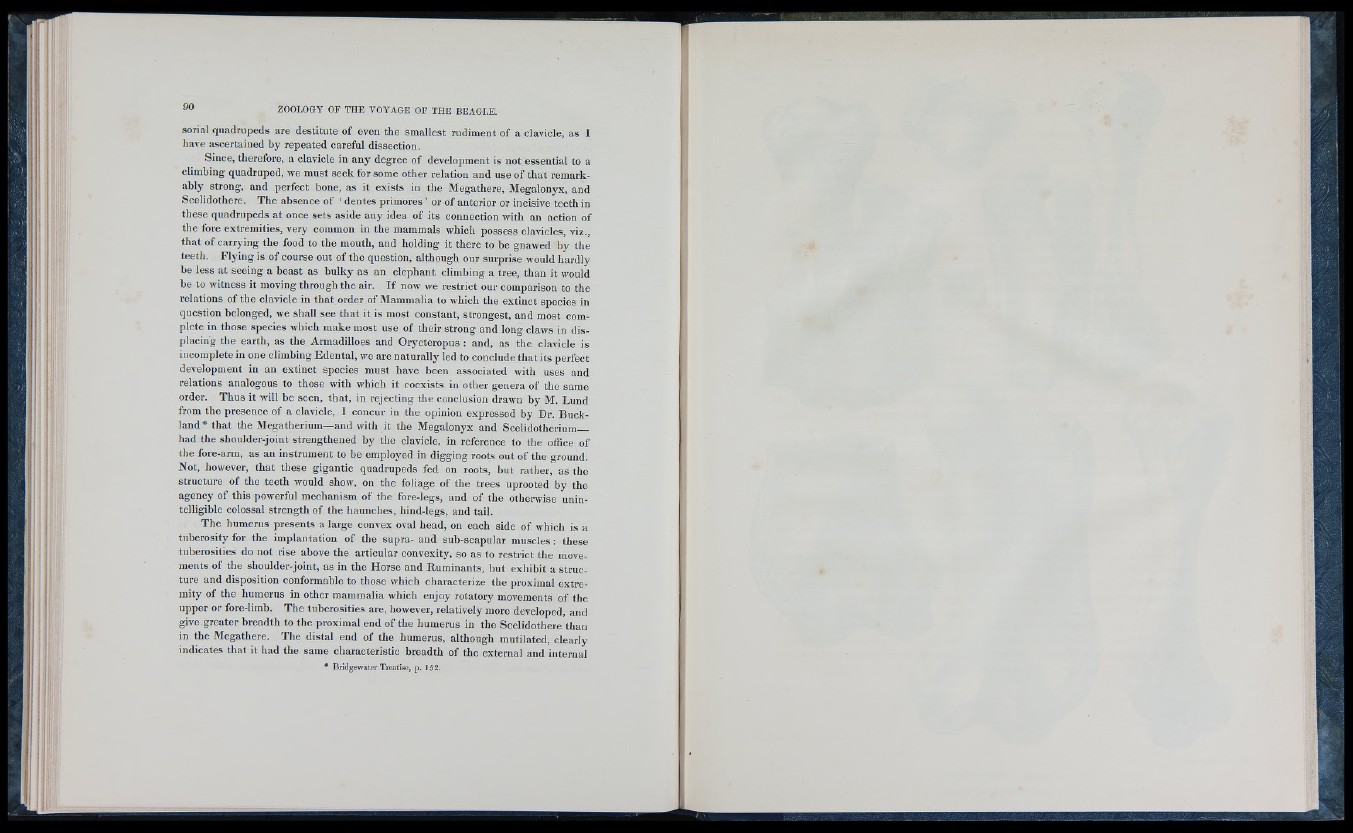
serial quadrupeds are destitute o f even the smallest rudiment o f a clavicle, as I
have ascertained by repeated careful dissection.
Since, therefore, a clavicle in any degree o f development is not essential to a
climbing quadruped, we must seek for some other relation and use o f that remarkably
strong, and perfect bone, as it ex ists in the Megathere, Megalonyx, and
Scelidothere. The absence o f ‘ dentes primores ’ or o f anterior or incisive teeth in
these quadrupeds at once se ts aside any idea o f its connection with an action o f
tlie fore extremities, very common in the mammals which p o ssess clavicles, viz.,
that o f carrying the food to the mouth, and holding it there to be gnawed by the
teeth. F ly in g is o f course out o f the question, although our surprise would hardly
be le ss at se e ing a beast as bulky as an elephant climbing a tree, than it would
be to witness it moving through the air. I f now we restrict our comparison to the
relations o f the clavicle in that order o f M ammalia to which the extinct spe cie s in
question belonged, we shall see that it is most constant, strongest, and most complete
in those spe cie s which make most u se o f their strong and long claws in displacing
the earth, as the Armadilloes and Orycteropus : and, as the clavicle is
incomplete in one climbing Edental, we are naturally led to conclude th a tits perfect
development in an extinct spe cie s must have been associated with use s and
relations analogous to those with which it coexists in other genera o f the same
order. Thus it will be seen, that, in rejecting the conclusion drawn by M. Lund
from the presence o f a clavicle, I concnr in the opinion expressed by Dr. Buckland*
that the Megatherium—and with it the Megalonyx and Scelidotherium—
had the shoulder-joint strengthened by the clavicle, in reference to the office o f
the fore-arm, as an instrument to be employed in digging roots out o f the ground.
Not, however, that these gigantic quadrupeds fed on roots, but rather, as the
structure o f the teeth would show, on the foliage o f the trees uprooted by the
agency o f this powerful mechanism o f the fore-legs, and o f the otherwise unintelligible
colossal strength o f the haunches, hind-legs, and tail.
The humerus presents a large convex oval head, on each side o f which is a
tuberosity for the implantation o f the supra- and sub-scapular muscles : these
tuberosities do not rise above the articular convexity, so as to restrict the movements
o f the shoulder-joint, as in the Horse and Ruminants, hut exhibit a structure
and disposition conformable to those which characterize the proximal extremity
o f the humerus in other mammalia which enjoy rotatory movements o f the
upper or fore-limb. The tuberosities are, however, relatively more developed, and
give greater breadth to the proximal end o f the humerus in the Scelidothere than
in the Megathere. The distal end o f the humerus, although mutilated, clearly
indicates that it had the same characteristic breadth o f the external and internal
* Bridgewater Treatise, p. 152.